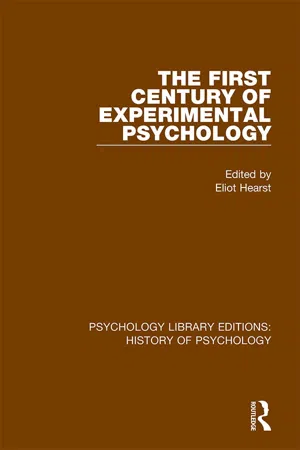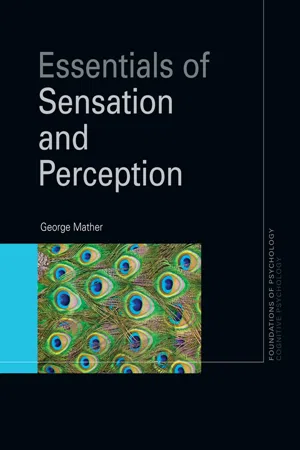Computation
Computation refers to the processing of information through mathematical or logical operations. In psychology, computation is used to understand how the brain processes and manipulates information, such as in cognitive processes like memory, attention, and decision-making. It involves studying the mechanisms and algorithms underlying mental processes to better comprehend human cognition and behavior.
6 Key excerpts on "Computation"
- eBook - ePub
An Introduction to Cognitive Psychology
Processes and Disorders
- David Groome(Author)
- 2021(Publication Date)
- Routledge(Publisher)
...chapter 1 Introduction to cognitive psychology David Groome DOI: 10.4324/9781351020862-1 Contents 1.1 Cognitive processes 1.2 Experimental cognitive psychology 1.3 Computer models of information processing 1.4 Cognitive neuroscience and neuropsychology 1.5 Automatic processing 1.6 Minds, brains, and computers Summary Further reading 1.1 Cognitive processes A definition of cognitive psychology Cognitive psychology has been defined as the psychology of mental processes, or more specifically the way in which the brain processes information. Cognition includes the way we take in information from the outside world, how we make sense of that information, and what use we make of it. Cognition thus involves various different kinds of information processing, which occur at different stages. Cognitive psychology The study of the way in which the brain processes information. It includes the mental processes involved in perception, learning and memory storage, thinking, and language. Stages of cognitive processing The main stages of cognitive processing are shown in Figure 1.1, arranged in the sequential order in which they would typically be applied to a new piece of incoming sensory input. Figure 1.1 The main stages of cognitive processing. Information taken in by the sense organs goes through an initial stage of perception, which involves an analysis of its content. Even at this early stage of processing the brain is already extracting meaning from the input, in an effort to make sense of the information it contains. The process of perception will often lead to the making of some kind of record of the input received, and this involves learning and memory storage. Once a memory has been created for some item of information, it can be stored for later use to assist the individual in some other setting or task. This will normally require the retrieval of the information. Retrieval is sometimes carried out for its own sake, merely to access some information stored in the past...
- eBook - ePub
Cognitive Psychology and Information Processing
An Introduction
- R. Lachman, J. L. Lachman, E. C. Butterfield(Authors)
- 2015(Publication Date)
- Psychology Press(Publisher)
...These chapters concern knowledge, meaning, and understanding, which are present in most cognitive acts and are ubiquitous in human affairs. During the revolutionary phase of cognitive psychology, "meaning" was barely visible as subject matter. Now, the importance of meaning and the various cognitive roles it plays thread their way through all of the later chapters of the book. D. Analogies Although the computer analogy is pervasive in information-processing psychology, it should be clear by now that the computer is more than just a metaphor. For some cognitive psychologists, those human properties that involve symbol manipulation are instances of the same theoretical abstraction that serves as the conceptual prototype for digital computers. At the same time, many information-processing psychologists view their theorizing as analogical rather than instantiational. Either way, the computer and its properties have had a profound influence on psychological research and theory. The likening of the mind to a computer program has provided us with very many productive ideas, and it promises more as computer science progresses. While the lode of ideas provided by the computer analogy seems far from exhausted, the analogy of the mind with a limited-capacity communications channel appears to have been pushed to the end of its usefulness. We still use some concepts provided by the communications-channel analogy, such as limited capacity and efficiency in human cognition. However, little recent research has relied directly on this analogy for hypotheses. E. Concepts and Language Some of the terms used by information-processing psychologists are the same as those of other paradigms, but they usually have a somewhat different meaning for us. For us, stimulus and response are laboratory terms, defining laboratory operations. A stimulus is whatever we present to the subject in an experiment, and his response is whatever he does that we measure...
- eBook - ePub
- Elliot Hearst, Eliot Hearst(Authors)
- 2019(Publication Date)
- Routledge(Publisher)
...By integrating the belief that thought could be viewed as a higher level skill (Bartlett, 1958) with the quantitative metrics of the mathematical theory of information (Shannon & Weaver, 1949), psychologists in England and the United States had already created an empirical basis for a field of cognition in studies of perception, problem solving, and language (see Neisser, 1967, for a review). The skillful use of computers (Newell, Shaw, & Simon, 1958) as a tool for the study of problem solving had led psychologists to propose cybernetic principles as a replacement for the ancient reflex arc (Miller, Galanter, & Pribram, 1960). The view of the human as an information processing system, analogous to a digital computer, has played a crucial role in the study of the higher mental processes. But its importance can only be appreciated in the light of more general changes in the definitions, goals, and methods of psychology during its first century. The original definition of psychology was the study of conscious mental events through systematic introspection by subjects into their mental processes. It was assumed by the earlies workers in the field both that psychology was uniquely relevant to humans and that consciousness could be understood in isolation from nonconscious processes. These assumptions led to particular views about the nature of thought that characterized Wundt and his immediate followers. The pervasive influence of evolutionary theory swept these assumptions aside by forcing consideration of links between humans and other animals. Psychologists influenced by the resulting “Behaviorism” suggested a delay in the study of human mental life until the fundamental structure of associations could be understood through animal experimentation. Often this behaviorist period (roughly 1910–1950) is seen as being wholly unproductive for the study of thought. Such a view is probably not completely justified...
- eBook - ePub
- George Mather(Author)
- 2014(Publication Date)
- Routledge(Publisher)
...A processing scheme in which information flows down from higher levels to lower levels of analysis, using prior knowledge and experience to steer lower level processes. Computational neuroscience. A modern discipline that attempts to understand brain function by analyzing and simulating the Computations that it performs. There is still some debate regarding the exact nature of internal representation in the brain. Marr argued that sensory representations are symbolic even at the very earliest stages of processing. More recent theories use analog representations much more extensively, as you will see in the next two chapters. Summary Modern theories of perception are based on conceptual foundations laid by three mathematicians; Alan Turing, Claude Shannon, and David Marr. Turing established the mathematical basis for computer models of human perception and cognition. Shannon’s information theory supplies the mathematical tools for understanding information transmission in sensory systems. Marr’s theory of vision emphasized the need to consider perception at an abstract, Computational level. Nearly all modern theories of perception are representational theories. Internal representations correspond to particular patterns of brain activity, and can take two forms, analog and symbolic. Each stage of sensory processing receives a representation from the previous stage, and passes on a new representation to the next stage. The transformation from one representation into another can be described as a Computation; manipulation of quantities and symbols based on a set of rules. Reflective Exercise 1. Which of the following factors does not have a bearing on coding efficiency, according to information theory: a. Channel capacity b. Redundancy c. Noise d. Gist 2. Apply the concepts of representation and Computation to what you know about neural processing in the olfactory system. 3...
- eBook - ePub
- Michael D. Rugg, Michael D. Rugg(Authors)
- 2013(Publication Date)
- Psychology Press(Publisher)
...CHAPTER 2 Theories of cortical Computation William A. Phillips 2.1 Introduction If we are ever to understand how the mammalian cerebral cortex works then we will have to understand the work that it does. Theories of cortical Computation must therefore play a crucial role in cortical neurobiology and neuropsychology. Many such theories have been proposed, and although none has gained general acceptance, many may have useful insights to offer. Just a few are outlined here. For other views on these issues see Abeles (1991),Arbib (1995), Gluck & Rumelhart (1990), Schwartz (1990), Churchland & Sejnowski (1992) and Koch & Davis (1994). By “Computation” I simply mean any procedure for transmitting, recoding, combining, storing or using information, where “information” is defined as in the very general conception provided by Shannon & Weaver (1949). Variablity and uncertainty are at the heart of this conception. Information in this sense is anything that reduces uncertainty about things that vary. Sections 2.2 and 2.3 of this chapter are concerned with general strategic issues. Section 2.4 asks “What basic Computational capabilities do the various cognitive subsystems require?”, and “What cortical circuitry is available to provide those capabilities?”. The focus there, and throughout the chapter as a whole, is upon capabilities and mechanisms that are common to many different regions of cortex. Section 2.5 gives a brief overview of the elements of Computation in neural systems, i.e. the local processing units, the architectures, the relation between knowledge and processing, and the procedures for learning. The remaining five sections then outline five different hypotheses concerning the basic goals of cortical Computation...
- eBook - ePub
Psychology in Historical Context
Theories and Debates
- Richard Gross(Author)
- 2017(Publication Date)
- Routledge(Publisher)
...This is conceptually similar to how we assume symbolic information flows through human information channels (as in the MSM; see text above). ● All computers have a central processing unit (CPU), which carries out the manipulation of information. At the simplest level, a central processor might take a sequence of numbers and combine them according to a particular rule in order to compute an average. Many Cognitive Psychologists see this as comparable to how people perform the same operation. ● Computers have databases and information stores, which are permanent representations of knowledge the computer has acquired. In many ways, this is comparable to our (permanent) LTM. ● Information sometimes needs to be held temporarily while some other operation is performed. This is the job of the information buffer, a feature of computers and information-processing models of human attention (see Gross, 2015) and memory (see text above). (Based on Parkin, 2000) Pause for thought … 3 Based on Box 7.12, how valid do you consider the computer analogy to be? 4 How useful in general do you consider analogies in Psychology to be? Perhaps surprisingly, although Pinker (1997) believes that thinking is Computation, that doesn’t mean that the computer is a good analogy for the mind. Some of the most important reasons for his dislike of the analogy relate to his support of the principles of Evolutionary Psychology (see Chapter 8). Can computers ever be like brains? According to Modha (2014), an IBM researcher, current computers are very logical, sequential (serial), and quantitative. They’re based on a 70-year-old architecture that separates memory from processing, and works in a step-by-step fashion, executing a series of pre-written ‘if X, then do Y’ equations. They’re fast number-crunchers and can process a lot of data – but they don’t really think...





